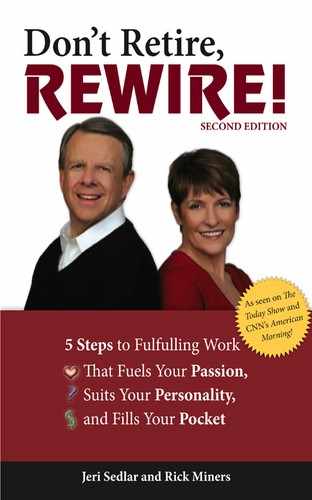| 1. | Hubler, Eric. “The New Faces of Retirement.” Sunday New York Times. January 3, 1999. |
| 2. | Weintraub, Pamela. “Finding the Fountain of Youth.” August 8, 2001, www.mygeneration.org/departments/2001/health/0705_a.html. |
| 3. | Sadler, William A. The Third Age: Six Principles for Growth and Renewal After Forty. Perseus Publishing, 2000, p. 17. |
| 4. | Rosen, Jan M. “The Other Retirement Choice.” New York Times. August 1, 1999, pp. 3–10. |
| 5. | Hilsenrath, Jon E. “Retirees Becoming Wealthier, Healthier.” Wall Street Journal. May 12, 2001, p. A-2. |
| 6. | Rosen, Jan M. “The Other Retirement Choice.” New York Times. August 1, 1999, pp. 3–10. |
| 7. | Carter, Jimmy, and Rosalynn Carter. Everything to Gain: Making the Most of the Rest of Your Life. Random House, 1987, p. 62. |
| 8. | Handy, Charles. The Age of Unreason. Harvard Business School Press, 1989, pp. 184–185. |
| 9. | Handy, Charles. The Age of Unreason. Harvard Business School Press, 1989, pp. 185–186. |
| 10. | Handy, Charles. The Age of Unreason. Harvard Business School Press, 1989, p. 173. |
| 11. | www.census.gov/compendia/statab/labor_force_employment_earnings/, Table 574 “Civilian Labor Force and Participation Rates With Projections: 1980 to 2014” |
| 12. | Rosen, Jan M. “The Other Retirement Choice.” New York Times. August 1, 1999, pp. 3–10. |
| 13. | Rimer, Sara. “Enjoying the Ex-Presidency? Never Been Better,” New York Times. February 16, 2000, p. H-1. |
| 14. | Gardyn, Rebecca. “Retirement Redefined,” American Demographics. November 2000, p. 52. (Having a “new job” refers to being employed for 12 months or fewer.) |
| 15. | Gardyn, Rebecca. “Retirement Redefined,” American Demographics. November 2000, p. 52. |
| 16. | Shellenbarger, Sue. “Work and Family.” Wall Street Journal. May 23, 2001, p. B-1. |
| 1. | Online interview with Richard Bolles and Steve Willey, financial and career editor, www.myprimetime.com, January 11, 2001. |
| 2. | Schoofs, Mark. “Spotting AIDS in Africa Shaped Doctor’s Destiny.” Wall Street Journal. May 30, 2001, p. B1. |
| 1. | Hardy, Michael. “Partnership to Feds: Hire Retired Private-Sector Workers.” FCW.com. January 10, 2007. |
| 2. | Kanchier, Carole. “Career Pros: Mature Worker Myths and Realities.” California Job Journal. January 30, 2005. |
| 3. | Shellenbarger, Sue. “Baby Boomers Already Are Getting Agitated Over Age-Bias Issues.” Wall Street Journal. May 30, 2001, p. B-1. |
| 4. | Moore, Brian. “The Towers of Babble.” New York Post. October 9, 2006, pp.38–39. |
| 5. | Strauss, Robert L. “Never Say Never.” Stanford Business Review. August 2001, p. 18. |
| 6. | Rosenblatt, Roger. Rules for Aging: Resist Normal Impulses, Live Longer, Attain Perfection. Harcourt, Inc., 2000, p. 97. |
